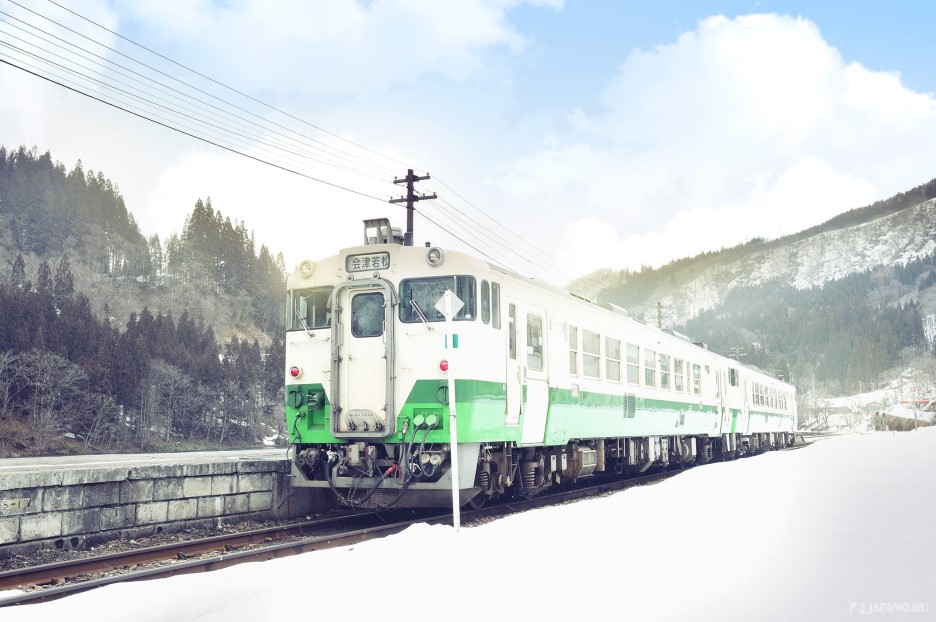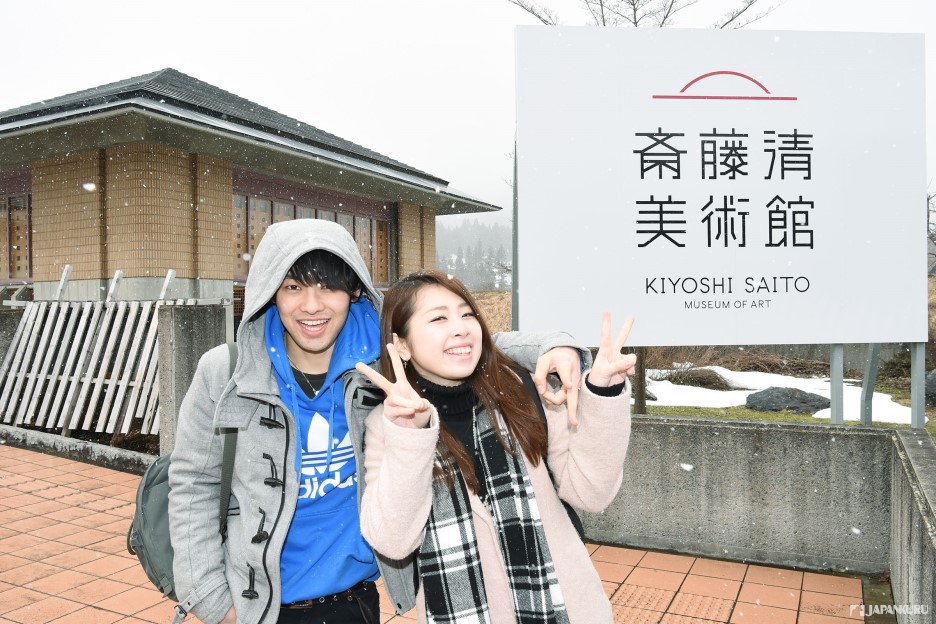
CONTENTS
Un Monde Blanc comme Neige
Nous avons pris nos valises pour la magnifique ville de Fukushima dans le Nord du Japon. Fukushima est couvert de neige pendant une longue période de l’année. Autant dire que les paysages enneigés vont vous ravir!
Embarquez sur la Ligne Tatami
Gare de Tokyo → Station de Koriyama
Via le Shinkansen Tōhoku, le trajet ne prend que 84 minutes pour rejoindre la station de Koriyama.
Station Koriyama → Station Aizu Wakamatsu
Arrivé à Koriyama, nous avons pris la correspondance sur la Ligne Banetsusai pour 70 minutes de plus direction Aizuka Wamatsu. Le trajet coûte seulement 1144 yens. Si vous souhaitez plus d’informations concernant les pass de train veuillez visiter la Page Web!
Station JR Aizu Wakamatsu
Aizu Wakamatsu est une ville largement connu pour ses usines de produits électroniques, de fibres ainsi que de meubles. La ville est également populaire pour ses cultures et magnifiques paysages!
‘Akabeko’ (赤べこ) est le boeuf rouge symbole de la région de Yanaizu. Il est dit qu’autrefois un très large séisme avait frappé Aizu et fait de nombreux dégâts et victimes. D’après la légende l’’Akabeko’ refusa de quitter les lieux de la construction du temple Enzō-ji et devint le symbole de la région. Cette légende a encore aujourd'hui une forte empreinte sur les locaux.
La Ligne Tadami, Un Train Local Splendide
La Ligne Tadami a ouvert en 1942 et est opérée par la compagnie JR. Elle parcourt 135 km joignant les stations d’Aizu Wakamatsu dans la préfecture de Fukushima et Koide dans la préfecture de Niigata, pour un total de 37 stations.
Encore aujourd’hui nous avons pu voir les dégâts causés par le tsunami de 2011. 7 stations étaient encore fermées lors de notre passage mais pas d’inquiétude des bus étaiet là pour faire la navette entre ces stations.
Premier arrêt → Aizu-Yanaizu
Depuis la station d’Aizu Wakamatsu le trajet ne prend qu’une petite heure. N’oubliez pas de descendre au 11ème arrêt. Il y avait très peu de monde à la station, nous avons donc profité pour se poser pour nous réchauffer. Notre voyage ne fait que commencer! Laissez-nous vous présenter les différents lieux que nous avons pu parcourir ;
❶ Goûtez au ‘Awa Manjū’
On dit qu’un moine aurait confectionné ces gâteaux cuits à la vapeur il y a 170 ans pour porter chance aux locaux. Ils sont devenus aujourd’hui une confiserie classique que l’on rapporte en souvenir à sa famille!
❷ Visitez le Musée Kiyoshi Saitō
Kiyoshi Saitō, né en 1907 était un peintre et graveur sur bois. Dans la plupart de ses oeuvres il faisait allusion à sa ville natale Aizu. Le musée est un bon moyen d’entre-apercevoir l’âme de la ville d’Aizu et ses paysages environnants.

Fermé tous les Lundis (fermé le mardi en cas de jour férié la veille)


❸ Goûtez aux mets locaux au Restaurant ‘Kachan no Manmaya’
Tous les plats préparés ici sont confectionnés avec des produits locaux! C’est donc le meilleur endroit pour se faire une idée des saveurs de la région. Le nom du restaurant ‘Kachan no Manmaya’ (かあちゃんのまんまや, littéralement ‘A la table de Maman) annonce directement l’ambiance chaleureuse du lieu!
Ce buffet est extrêmement populaire auprès des locaux! Jetez donc un oeil au nombre de client lors de notre passage.
Le buffet de midi ne coûte d’ailleurs que 880 yens!! Oui, vous avez bien entendu SEULEMENT 880 yens!
Ce jour là nous avons choisi de goûter aux différentes salades, au poulet grillé ainsi qu’au tofu frit avec des pommes de terre.
Prochain arrêt → Aizu Kawaguchi
Afin de rejoindre la station d’Aizu Kawaguchi, nous avons dû emprunter le bus pour rejoindre la station suite aux dégâts causés par le tsunami de 2011.
Puisque nous avions pas mal de temps devant nous, nous avons décidé de nous arrêter dans un ‘Onsen’ (温泉 sources chaudes thermales). Ici l’eau gazeuse est douce, fait assez rare pour être noté! On dit que cette eau est parfaite pour cuisiner car elle est forte en fer, les jeunes femmes en raffolent!

Dernier arrêt → Tadami
Encore une fois malheureusement nous n’avons pas pu emprunter le train pour rejoindre cette station! Le bus restait tout de même une bonne expérience.
Minshuku ‘Tadamisō’
Les ‘Minshuku’ (民宿) sont des chambres d’hôtes chez l’habitant. C’est un bon moyen de se familiariser avec l’histoire de la région et de faire de jolies rencontres.

7000 yens par personne (chambre double・dîner et déjeuner compris)

Page de réservation
Un Minshuku agréable
Nous avons vraiment été chanceux de trouver un endroit aussi confortable. Le service était bon et le personnel vraiment agréable!
Une ambiance chaleureuse
L’ambiance ici nous faisait nous sentir comme à la maison! Nous avons adoré ce logement.
Chambre traditionnelle avec tatami et ‘Kotatsu’ (こたつ, table avec couverture et chauffage pour se réchauffer durant l’hiver). La chambre était même équipée d’un réfrigérateur et d’un large évier!
Nous ne nous attendions pas à recevoir un repas aussi copieux dans un minshuku! Tout est d’ailleurs préparé par le propriétaire et laissez-nous vous dire que c’était un régal! Les nouilles faites maison étaient vraiment succulentes!
Nous n’avons pas fini de découvrir le Nord du Japon! Rejoignez-nous pour le Jour ❷ de notre voyage.
Restez connectés pour de nouveaux articles originaux tous les jours sur JAPANKURU
N'hésitez pas à nous suivre également sur nos réseaux Facebook et Instagram pour plus d'histoires japonaises!
Details
ACCESS:Station Aizu Wakamatsu
COMMENT
FEATURED MEDIA
VIEW MOREMAP OF JAPAN
SEARCH BY REGION

LATEST
VIEW MOREEVENT CALENDAR
VIEW MOREMOST POPULAR
 Tokyo Winter Recommendation: Don’t Miss Tokyo Mega Illumination, Japan’s #1 Light Show
Tokyo Winter Recommendation: Don’t Miss Tokyo Mega Illumination, Japan’s #1 Light Show ป้ายยาสินค้าน่าซื้อในร้านขายยาญี่ปุ่น | KOWA ผลิตภัณฑ์เพื่อสุขภาพสำหรับคนยุคใหม่
ป้ายยาสินค้าน่าซื้อในร้านขายยาญี่ปุ่น | KOWA ผลิตภัณฑ์เพื่อสุขภาพสำหรับคนยุคใหม่ Okinawa Family Road Trip: Japanese Glasses Shopping at San-A Urasoe West Coast PARCO CITY, Discount Coupons, & Okinawa Sightseeing with JINS
Okinawa Family Road Trip: Japanese Glasses Shopping at San-A Urasoe West Coast PARCO CITY, Discount Coupons, & Okinawa Sightseeing with JINS






























 >> Find out more at Japankuru.com! (link in bio)
#
>> Find out more at Japankuru.com! (link in bio)
#





 The Robot Restaurant is gone, but the Samurai Restaurant is here to take its place. Check it out, and don't forget your coupon!
The Robot Restaurant is gone, but the Samurai Restaurant is here to take its place. Check it out, and don't forget your coupon!
 신주쿠의 명소 로봇 레스토랑이 사무라이 레스토랑으로 부활! 절찬 쿠폰 발급중
신주쿠의 명소 로봇 레스토랑이 사무라이 레스토랑으로 부활! 절찬 쿠폰 발급중
 18歲以上才能入場的歌舞秀,和你想的不一樣!拿好優惠券去看看~
#tokyo #shinjuku #samurairestaurant #robotrestaurant #tokyotrip #도쿄여행 #신주쿠 #사무라이레스토랑 #이색체험 #할인이벤트 #歌舞伎町 #東京景點 #武士餐廳 #日本表演 #日本文化體驗 #japankuru #japantrip #japantravel #japanlovers #japan_of_insta
18歲以上才能入場的歌舞秀,和你想的不一樣!拿好優惠券去看看~
#tokyo #shinjuku #samurairestaurant #robotrestaurant #tokyotrip #도쿄여행 #신주쿠 #사무라이레스토랑 #이색체험 #할인이벤트 #歌舞伎町 #東京景點 #武士餐廳 #日本表演 #日本文化體驗 #japankuru #japantrip #japantravel #japanlovers #japan_of_insta
 코지마 x 빅 카메라 쿠폰으로 일본 가전 제품 쇼핑하기
#pr #japankuru #japanshopping #kojima #biccamera #japaneseskincare #yaman #dji #osmopocket3 #skincaredevice #日本購物 #美容儀 #相機 #雅萌 #日本家電 #일본여행 #면세 #여행꿀팁 #일본쇼핑리스트 #쿠폰 #일본쇼핑 #일본브랜드 #할인 #코지마 #빅카메라 #japankurucoupon
코지마 x 빅 카메라 쿠폰으로 일본 가전 제품 쇼핑하기
#pr #japankuru #japanshopping #kojima #biccamera #japaneseskincare #yaman #dji #osmopocket3 #skincaredevice #日本購物 #美容儀 #相機 #雅萌 #日本家電 #일본여행 #면세 #여행꿀팁 #일본쇼핑리스트 #쿠폰 #일본쇼핑 #일본브랜드 #할인 #코지마 #빅카메라 #japankurucoupon











































